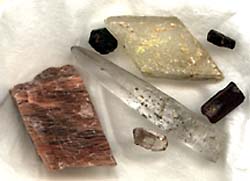| Revision as of 05:21, 17 December 2002 view sourceIsis~enwiki (talk | contribs)5,430 editsmNo edit summary← Previous edit | Revision as of 23:38, 17 December 2002 view source Ktsquare (talk | contribs)Administrators11,347 editsmNo edit summaryNext edit → | ||
| Line 13: | Line 13: | ||
| Some important rock-forming minerals include the ], ], ], ], ], ], and ]. Other well-known minerals include the wide variety of ]. | Some important rock-forming minerals include the ], ], ], ], ], ], and ]. Other well-known minerals include the wide variety of ]. | ||
| Trying to list all the minerals here would probably be counter-productive; maybe they can be linked from their chemical compositions (eg ''Silicon dioxide''->], ], ])? | Trying to list all the minerals here would probably be counter-productive; maybe they can be linked from their chemical compositions (eg '']''->], ], ])? | ||
| The physical hardness of a mineral is usually measured on the ]. | The physical hardness of a mineral is usually measured on the ]. | ||
Revision as of 23:38, 17 December 2002
Minerals are natural compounds formed through geological processes. The term "mineral" encompasses not only the material's chemical composition but also the arrangement of atoms in its molecular structure.
Minerals can be compared to rocks, which are usually mixtures of several different minerals.
These range in composition from elements and simple salts to very complex silicates (with most organic compounds usually excluded), with thousands of known forms. To be classified as a true mineral, a substance must be a solid and have a crystal structure. Mineral-like substances that don't strictly meet the definition are sometimes classified as mineraloids.
The study of minerals is called mineralogy.

Photo from US Geological Survey
Some important rock-forming minerals include the feldspars, quartz, olivines, pyroxenes, garnets, micas, and calcite. Other well-known minerals include the wide variety of gemstones.
Trying to list all the minerals here would probably be counter-productive; maybe they can be linked from their chemical compositions (eg Silicon dioxide->Quartz, Chalcedony, Opal)?
The physical hardness of a mineral is usually measured on the Mohs scale of mineral hardness.
Dietary mineral refers to inorganic compounds necessary for life and good nutrition.
Some of these are scientific minerals as salt; others are elements, as potassium, calcium, iron, zinc, magnesium, copper.
These can be naturally occurring in food or added in elemental or mineral form to food, as calcium carbonate, iron fillings, etc.
Some of these additives are from natural sources as ground oyster shells for calcium carbonate.
Sometimes minerals are added to the diet separately from food, as vitamin and mineral supplements and in dirt eating, called pica or geophagy.
Selected Minerals
- Agate
- Analcim
- Barite
- Hematite
- Kainite, Kalsilite, Kamacite, Kaolinite, Keilhauite, Kernite, Kobellite, Kunzite
- Zircon